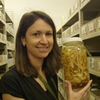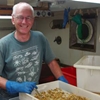General Description
Body about 4.7 x as long as wide, deeply vaulted, half as deep as wide. Head 1.7 times as wide as long, front convex, rostrum absent. Pereonite 1 as long as head; pereonites 2-7 subequal, longer than dorsal length of pereonite 1. Pleotelson 0.4 times body length, pleonites 1 and 2 indicated by complete dorsal sutures, pleonite 3 by ventrolateral sutures only, pleotelson rigid (pleotelsonic formula 2 + 1). Pleotelson broadest anteriorly, lateral margins evenly tapering to an acute apex. Body up to 6.4 cm long.
Biology
Pentidotea australis is the largest idoteid known from Australia, reaching 64 mm in length. Members of the family Idoteidae are known as sea centipedes but are not at all related to terrestrial centipedes which have many more pairs of legs and never enter the sea. These species belong to one of the few families of herbivorous isopods. They can camouflage themselves according to the colour of the marine algae in which they live.
Habitat
Subtidal algae, to depths to 5 m.
Reefs
Coastal shores
Distribution guide
Southern Australia.
Species Group
Depth
Shore (0-1 m)
Shallow (1-30 m)
Water Column
Max Size
6.4 cm
Diet
Herbivore
Commercial Species
No
Global Dispersal
Native to Australia
Conservation Status
- DSE Advisory List : Not listed
- EPBC Act 1999 : Not listed
- IUCN Red List : Not listed






